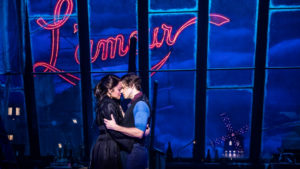 The camera doesn’t lie–while it may be a publicity still, the photo above is exactly what greets you when you enter the Hirschfeld for Moulin Rouge! The Musical! The former home of Kinky Boots is kicking up its skirts for the latest movie-into-musical, and the wonder is why it took 18 years. Baz Luhrmann’s Oscar-winning hit is a stage natural that fits right into the snugly sinuous theater, elephant and windmills and all.
The camera doesn’t lie–while it may be a publicity still, the photo above is exactly what greets you when you enter the Hirschfeld for Moulin Rouge! The Musical! The former home of Kinky Boots is kicking up its skirts for the latest movie-into-musical, and the wonder is why it took 18 years. Baz Luhrmann’s Oscar-winning hit is a stage natural that fits right into the snugly sinuous theater, elephant and windmills and all.
Moulin Rouge! (2001) didn’t invent the jukebox musical, but it cleverly repurposed it, taking bits and pieces of numerous Top Forty hits and applying a soundtrack-of-our-lives soundscape to a stock romantic tragedy from a sexy bohemian yesteryear. The Broadway version pumps up the volume; if about two dozen songs mix-mastered in the film seemed excessive, hang on, as there are some 70 in the show, including more up-to-the-minute greatest hits from Adele, Lady Gaga, and Katy Perry.
But the effect is more exciting than overwhelming, a problem with the film, whose unrelenting editing rarely paused for breath. Live may be more complementary for the effect; your eyes are riveted to the stars, to the chorus, wherever the focus is. (Luhrmann served as creative consultant.) From the get-go–a pre-show act, followed by a dynamic staging of “Lady Marmalade”–it hooks you more deeply. That the stars of the show have greater vocal range and more supple dance technique than the stars of the movie (a perennial issue with contemporary movie musicals) is a major plus in putting it across. Simply put, the stage musical is the “spectacular spectacular” that the movie tried so hard to be, and sometimes was.
 As drama, however, Moulin Rouge! will always be a bit wanting. Book writer John Logan, a Tony winner for Red and a veteran screenwriter, mostly gets out of the way of the musical numbers in retelling the star-crossed love affair of sweet-natured songwriter Christian (Aaron Tveit, Next to Normal) and Moulin Rouge sensation and courtesan Satine (Karen Olivo, a Tony winner for West Side Story), slipping in dialogue scenes here and there (as in the film, some of the chatter is song lyrics, passed back and forth by the characters). But he and director Alex Timbers (whose adaptation of Beetlejuice is a textbook example of how not to bring a movie to musical stage life) have changed the emotional polarity of Satine, from Nicole Kidman’s breathier, fantasy portrayal to a harder-hearted, nobody’s fool version. Vulnerability is out in the #MeToo era, so here we have a Satine who looks and acts fully capable of beating consumption and her oily patron, the Duke (Tam Mutu). Olivo is terrific in sound and motion, but lacks the poignant softness that Kidman brought to the part, blunting the ending…
As drama, however, Moulin Rouge! will always be a bit wanting. Book writer John Logan, a Tony winner for Red and a veteran screenwriter, mostly gets out of the way of the musical numbers in retelling the star-crossed love affair of sweet-natured songwriter Christian (Aaron Tveit, Next to Normal) and Moulin Rouge sensation and courtesan Satine (Karen Olivo, a Tony winner for West Side Story), slipping in dialogue scenes here and there (as in the film, some of the chatter is song lyrics, passed back and forth by the characters). But he and director Alex Timbers (whose adaptation of Beetlejuice is a textbook example of how not to bring a movie to musical stage life) have changed the emotional polarity of Satine, from Nicole Kidman’s breathier, fantasy portrayal to a harder-hearted, nobody’s fool version. Vulnerability is out in the #MeToo era, so here we have a Satine who looks and acts fully capable of beating consumption and her oily patron, the Duke (Tam Mutu). Olivo is terrific in sound and motion, but lacks the poignant softness that Kidman brought to the part, blunting the ending…
…which segues into a fantastic curtain call, so the disappointment is lessened. This Moulin Rouge is all about sensation and atmosphere, with the great Danny Burstein clearly having a whale of a time as owner and MC Harold Zidler, whipping the company into frenzies. As Tveit, a steadying presence, expertly handles quieter numbers like “Your Song,” everyone else has a Big Moment: Mutu’s comes with his introduction, to “Sympathy for the Devil,” Ricky Rojas and Robyn Hurder enact a sizzling “Bad Romance” in dance (Sonya Tayeh is the choreographer); and Sahr Ngaujah (Fela!), a less twitchy Toulouse-Lautrec than John Leguizamo, knocks “Nature Boy” right out of the theater. (A real haymaker of a scene, one that works on the newly available original cast album but that only settles into your bones when experienced live.)
Timbers, who loves to play dress-up in his theatrical spaces, is stuck with the Winter Garden, a barn, for Beetlejuice. The more intimate Hirschfeld provides a more fertile playground, and the show is a field day for Derek McLane (sets), Catherine Zuber (costumes), Justin Townsend (lighting), and Peter Hylenski (sound). You’re bound to sing along with some of Moulin Rouge! while watching it; you’ll exit humming the production, a contact high I still feel.





Comments